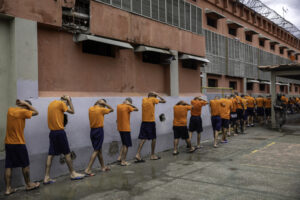Carina Solmirano, a researcher at the Stockholm International Peace Research Institute (SIPRI), talked to Adam Isacson and Lucila Santos about military expenditure in Latin America following the release of SIPRI Yearbook 2011.
Download 10-06-2011 (13.71 MB)
Duration: 23:52 m – Filetype: mp3 – Bitrate: 80 KBPS – Frequency: 44100 HZ
Subscribe to WOLA's "Latin America Today" podcast via RSS or iTunes.
Solmirano co-authored the Yearbook's chapter on global military spending (a free download of the chapter is available here – click on “Sample Chapter”). She pursued her doctoral studies at the University of Denver and previously worked on defense and regional security issues in Argentina. She is part of SIPRI's Military Expenditure Project, which monitors developments in military spending worldwide and maintains the most comprehensive, consistent and extensive data source available on the topic.
SIPRI's 2011 Yearbook revealed interesting aspects of the military expenditure landscape in Latin America:
-Surprisingly, South America is the region of the world where military spending grew most rapidly, by 5.8%, a total of US$63.3 billion. This is in stark contrast with a global rise in military expenditure of 1.3% in 2010. However, in absolute terms, South America continues to be one of the regions that spends the least on its militaries. To add some perspective, the US$63.3 billion spent by South America is slightly above that spent by France alone, and represents only 4% of the total global expenditure.
-Much of it has to do with Brazil’s increase in military expenditure with a 9.3% rise in the last year. Between 2001 and 2010, Brazilian military spending increased 30%. In 2010, Brazil’s share of GDP in military spending was 1.6%, compared with 2.1% of the world share.
-Brazil, along with the United States and several other big countries, is leading the global rise in military spending. Together with Russia, China, India, South Africa and Turkey, SIPRI explains that Brazil’s increase in military expenditure is due to a rapidly growing economy and its greater economic and political role in South America, Latin America, and globally. Brazil is developing, like the other countries, as a military power by engaging in military modernization programs. In Brazil’s case, its economic growth has been a key driver of the military modernization and spending. SIPRI also claims that, given Brazil's absence of traditional military threats or regional rivalries, the investment in its military may respond to the desire of building military power as a source of status.
-Curiously enough, Paraguay and Peru had military expenditure increases of 16%.
-The only exceptions to the rise in military spending in South America during 2010 have been Venezuela, Bolivia and Uruguay. In Venezuela’s case, the decline in expenditure was 27%, the highest drop in the region. Another not-expected case is that of Mexico, which despite deploying the military to fight internally against drug-trafficking, has only shown an increase of 2% in its military spending.
-Finally, some observations about SIPRI’s data: measured in US dollars, Brazil is the country that spent the most militarily (US$28,096), followed by Colombia (US$9,191) and Chile (US$6,198). Even more interesting is when we look at military expenditures as a share of each country’s GDP. In Brazil’s case is 1.6%, while Colombia and Chile show the higher percentages of their GDP spent in the military: 3.7% and 3.5% respectively.

